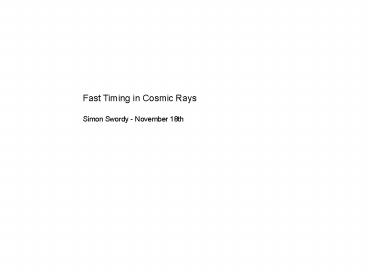Fast Timing in Cosmic Rays - PowerPoint PPT Presentation
Title:
Fast Timing in Cosmic Rays
Description:
calorimeter albedo rejection. Ground based. dual focus imaging systems. Mass id science ... albedo time ~several ns. pixel detectors would be much. better than ... – PowerPoint PPT presentation
Number of Views:12
Avg rating:3.0/5.0
Title: Fast Timing in Cosmic Rays
1
Fast Timing in Cosmic Rays Simon Swordy -
November 18th
2
- Above the atmosphere
- mass identification
- trigger and charge measurement
- calorimeter albedo rejection
- Ground based
- dual focus imaging systems
3
- Mass id science
- Be9/Be10 - age of cosmic rays should show time
dilation effects which map out the density of
material traveled versus time. Need lorentz
factors above 2. - He3/4 - material traveled as a function of
lorentz factor -gt required to find source energy
spectra of He - antiprotons - what do these do at high energy?
- anti-deuterium - is there any of this?
4
3m
5
(No Transcript)
6
(No Transcript)
7
What is the maximum detectable ? for a TOF system
with resolution ?t and a separation of 3m?
?t(ps) ?max
100 7.1
30 12.9
10 22.4
3 40.3
- probably interesting for Be9/10 and
anti-deuterium - not much good for He3/4 (need 100 or so)
- works in a region where there are no good
cherenkov radiators (ngt1.01 nlt1.1)
8
Calorimeter albedo problem
CREAM-2004
9
(No Transcript)
10
albedo time several ns pixel detectors would be
much better than paddles because of transit time
in paddles
11
Dual focal length cerenkov imaging
- TrICE (Track Imaging Cherenkov Experiment)
U. Chicago - ANL
18ns delay between images
12
Size of Direct Cherenkov spot -gt nucleus Z
- Dual focal length system
- 1st image wide angle includes shower-trigger
- 2nd image higher resolution finds direct
Cherenkov component -gt ns resolution would be
useful here
13
HOW MUCH? For a NASA experiment on balloons 1
detector plane of 1mx1m could be up to 250k -gt
25 per cm2 For an imaging cherenkov camera
0.6m x 0.6m could be 300k -gt 80 per
cm2 Probably needs to get below 100 per cm2
to be a contender.........































